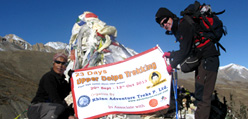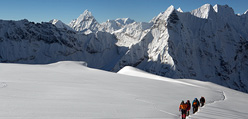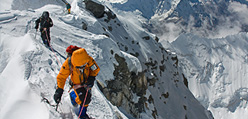Email : info@nepaltrekkingpackage.com
+977 - 01 - 4701300
Foods in Trekking
Food
When planning a trek, you needn’t worry about the availability or quality of food. Many of our clients tell us that the food they eat on the trail is even better than at their hotels in Kathmandu! One thing you will not fail to notice is that your appetite on the trek will be almost insatiable, which is why we recommend that you ‘eat local’ as much as possible, indulging in plates of daal bhat (lentils and rice), which are full of easy-to-digest carbohydrates and always come with second (and even third and fourth) helpings.
Typical meals along the trail will be as follows:
Breakfast
You’ll be able to order cereals, porridge and muesli, as well as bread with honey, peanut butter or jam, and eggs to order. Tea and coffee are also served in lodges or on our camping treks – we recommend that you take sugar to keep your energy up!
Lunch
In many regions, the chef will provide a simple meal of daal bhat, and if you are eating at lodges, there will be a range of options including chowmein, fried rice and other delicious options. In higher regions when camping, you may have to rely on simple or dried foods, including bread, boiled eggs, fruit, energy bars and cartons of juice. Along the trail you will stop at teahouses for a refreshing brew, and simple, locally produced packets of biscuits. Of course, you can also bring your own snacks – chocolate bars like Snickers and Mars are cheap and readily available in Kathmandu – it is wise to stock up on these before departure as they can be more expensive along the trail.
Dinner
If you are staying in teahouses, the ubiquitous daal bhat will be available, but increasingly even budget-level teahouses can whip up something much more suited to the Western palate. This can include pizzas made on chapattis, spaghetti and delicious noodle dishes. These lodges also offer desserts, including the famous Snickers Momo (something you should really only indulge in when walking long distances every day!), fruit pies and pancakes.
If camping, you’ll be pleasantly surprised at what can be produced. Meals include yak or buff steaks, Thai curries, and other international dishes, in addition to more local food. Our chefs enjoy dazzling trekkers with desserts and will be delighted to provide for those of you with special dietary requirements. Condiments are also available and there may even be delicacies like blue cheese, olives, salami and even imported wine!
Limitations
On longer trips at high altitudes, you may find there is a dearth of fresh vegetables, as well as things like eggs and fresh milk. Please be aware that while we try to provide the very best for our clients, there are limitations to what is available at high altitudes. Meat is occasionally taken for camping trips, and it might be possible to purchase chickens locally, which our chefs can then prepare for you in the evening.
Alcohol
We do not advocate excessive consumption of alcohol during treks; it can dehydrate you even into the following day, and should only ever be taken responsibly and after your body has had time to acclimatise. However, many lodges and teahouses will be able to provide beer, locally produced spirits, as well as the local moonshines of rakshi or chang. Invariably, we find that these are consumed in larger quantities on the last night of a trek – and why not? You’ll have earnt it!
Hygiene
Our chefs are trained to prepare their food using fully hygienic methods, and antiseptic water will be provided for you to wash your hands before mealtimes.
Of course, there is a risk that you’ll suffer a stomach upset while in Nepal. However, if you take sensible precautions then you should be able to avoid any major illness. In fact, the main risk of food poisoning comes not on the trek, but in restaurants and hotels in major cities.
You have to be especially careful when using untreated water – including when brushing your teeth. You should always use drinking water, either from packaged and sealed mineral water or from sources you know to have been boiled, filtered or treated with iodine tablets. On the trek, you can buy bottled water, but please be aware that this is both very expensive at high altitudes (remember, someone had to carry it up there on foot!) and also bad for the environment. Instead, bring a drinking water bottle, which can be refilled with boiled water. This can be reused again and again at no cost to the environment, and minimal cost to you!
Avoid eating leafy vegetables or any fresh produce that cannot be peeled, especially if you suspect the food was prepared in unsanitary conditions. Always wash your hands before eating and after using the toilet.


